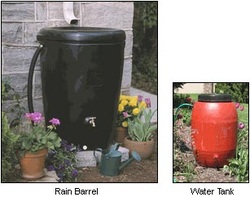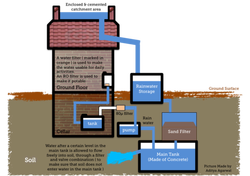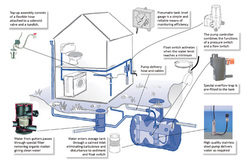Rainwater Harvesting
Getting and Storing Water
You can store water in a variety of ways: 55-gallon steel drums, oak barrels or underground storage tanks. For a simple storage system, place an oil drum or barrel on a raised platform under a rain gutter downspout. The barrel should have an external pipe with a shutoff valve to control the amount of water withdrawn. If you have designed your system properly, gravity will enable you to obtain water from the barrel to a drip irrigation system without a pump.
Rainwater harvesting systems overview
Rainwater is captured from the roof(s) and brought to a central point, via normal guttering and drain-pipes, to enter a storage tank (frequently underground), where it is filtered on entry. A highly efficient and reliable submersible pump delivers the water to the location required on demand; alternatively delivery can be to a normal header tank instead.
The size of the storage tank is determined by considering the amount of water available for storage (a function of roof size and local average rainfall) and the amount of water likely to be used (a function of the building’s occupancy and function).
Reasons for rainwater harvesting
· Rainwater harvesting (including rainwater recycling and some versions of greywater recycling) displace a large proportion of the water that would otherwise be provided by the mains supply – thus reducing overall water supply costs and the energy embodied in cleaning and transporting it.
· It can provide an off mains supply for remote areas ensuring security of supply.
· It enhances a property and gains Eco-homes rating points.
· It can form part of an attenuation and rainwater management scheme, by reducing storm-water runoff and controlling the flow rate off site.
· Increasingly planning departments are looking more favourable towards the concept of rainwater harvesting.
www.enviko.com/technology/rainwater-harvesting
You can store water in a variety of ways: 55-gallon steel drums, oak barrels or underground storage tanks. For a simple storage system, place an oil drum or barrel on a raised platform under a rain gutter downspout. The barrel should have an external pipe with a shutoff valve to control the amount of water withdrawn. If you have designed your system properly, gravity will enable you to obtain water from the barrel to a drip irrigation system without a pump.
Rainwater harvesting systems overview
Rainwater is captured from the roof(s) and brought to a central point, via normal guttering and drain-pipes, to enter a storage tank (frequently underground), where it is filtered on entry. A highly efficient and reliable submersible pump delivers the water to the location required on demand; alternatively delivery can be to a normal header tank instead.
The size of the storage tank is determined by considering the amount of water available for storage (a function of roof size and local average rainfall) and the amount of water likely to be used (a function of the building’s occupancy and function).
Reasons for rainwater harvesting
· Rainwater harvesting (including rainwater recycling and some versions of greywater recycling) displace a large proportion of the water that would otherwise be provided by the mains supply – thus reducing overall water supply costs and the energy embodied in cleaning and transporting it.
· It can provide an off mains supply for remote areas ensuring security of supply.
· It enhances a property and gains Eco-homes rating points.
· It can form part of an attenuation and rainwater management scheme, by reducing storm-water runoff and controlling the flow rate off site.
· Increasingly planning departments are looking more favourable towards the concept of rainwater harvesting.
www.enviko.com/technology/rainwater-harvesting



